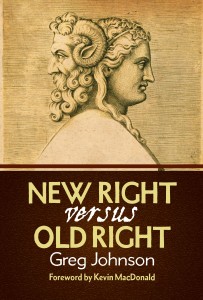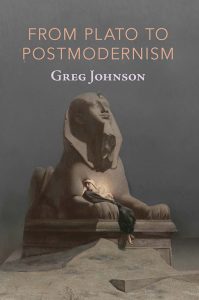The Paranoid Style in White Nationalism
Posted By Greg Johnson On In North American New Right | Comments DisabledIf you think this essay is about you, you might be paranoid.
Guardians of the conventional wisdom frequently accuse White Nationalists of being “paranoid” when we express fears of non-white crime, white demographic decline, race replacement immigration, and ultimately white extinction and white genocide.
White Nationalists are also frequently accused of “phobias” like “xenophobia” (the fear of aliens).
These accusations are not psychiatric diagnoses. They are not offered to help us. They are just cheap rhetorical attacks, attempts to dismiss our concerns as irrational. By pathologizing our views, our enemies seek to frighten off conventional-minded people who might otherwise take our ideas seriously. They might even gaslight the weakest among us into doubting their own sanity.
But in truth, White Nationalist fears of non-white crime, multiculturalism, and race-replacement immigration are quite reasonable. Even our most alarming ideas—white extinction [2] and white genocide [3]—are, unfortunately, based on objective facts and sober analysis.
Jewish historian Richard Hofstadter’s 1964 essay “The Paranoid Style in American Politics [4]” is often name-dropped as a classic treatment of political paranoia, but it is a disappointingly superficial magazine article, published in Harpers in November of 1964 against the backdrop of the Barry Goldwater–Lyndon Johnson presidential race.
 [5]
[5]You can buy Greg Johnson’s The White Nationalist Manifesto here [6]
Hofstadter does not reflect on the idea of paranoia; he simply uses it in an attempt to pathologize conspiracy theories and gaslight people who are inclined to think in conspiratorial terms. Nor does Hofstadter refute any of the conspiracy theories he mocks, and for good reason: they all have more than a kernel of truth, particularly Senator Joseph McCarthy’s warnings of Communist infiltration of the US government.
Frankly, the only good feature of Hofstadter’s essay is its title, which is why it is more often cited than read. I’m going to steal the phrase “the paranoid style” because, although the central claims of White Nationalism cannot be dismissed as paranoid, some people in our movement really do have a paranoid style—if not out-and-out paranoia—so the phenomenon needs to be taken seriously.
What follows are some notes on the paranoid style that will help us to identify it, with the ultimate aim of ridding ourselves of it. First of all, the paranoid style is bad optics. We are constantly being accused of paranoia and various phobias. There are easy arguments to counter these claims, but the best refutation is a matter of action. We simply should not behave like people in the grip of irrational fears. Second, the paranoid style is never far removed from actual paranoia, and crazy people don’t belong in a serious movement.
“Paranoia” literally means being out of one’s mind, from the Greek roots “para,” meaning outside or beside, and “noos,” meaning the mind. But paranoia refers to a much more specific form of derangement, namely holding irrational beliefs—but not just any irrational beliefs: irrational beliefs motivated by fear. Paranoids have irrational fears. The things they fear are irrational, and the way they fear them is irrational.
Fear is not necessarily irrational. Bad things happen all the time. By its nature, rational action pursues the good and avoids the bad. Whenever one is about to do something, it is entirely reasonable to ask, “What’s the worst that could happen?” among all other possible outcomes.
 [7]
[7]You can buy Greg Johnson’s Toward a New Nationalism here [8]
Paranoids don’t just fear the worst, they believe the worst, and they do so compulsively and irrationally. What makes a fear irrational? It is irrational to fear things that are unreal or unlikely to happen. Paranoids, however, can’t help it. For paranoids, fearing is believing.
In my experience, paranoids are not just delusional. They also want you to share their delusions, for if you share their delusions, the delusions seem more real and the paranoids feel less alone. Paranoia is a lonely and terrifying place. Paranoid ideation is not pleasant. It is a self-destructive compulsion akin to drug addiction. Paranoids are like moths frantically fluttering around a lightbulb until they die in fits of agony.
But how does one convince people of delusions? To do this, paranoids generally resort to two techniques: demanding that you treat them as authorities, so you simply accept their core delusions on faith, and making up tissues of lies that support belief in the core delusion. This is akin to the “pious fraud” who makes up stories about divine revelations and miracles to support core religious articles of faith.
One wonders if paranoids consciously lie to shore up their delusions or if some of them really believe the stories they improvise on the spot. Surely some of them are conscious liars who take pleasure in duping others because it makes them feel powerful. Naturally, if paranoids are willing simply to lie, they are also willing to use all lesser forms of deceptive rhetoric and emotional manipulation as well, and when those fail, they will move to screaming rage and physical assault.
 [9]
[9]You can buy Greg Johnson’s New Right vs. Old Right here [10]
The worst-case scenario in a debate is that one’s opponent is intellectually dishonest. Thus in debates, paranoids tend to go straight to accusations of bad faith. For paranoids, there are no honest disagreements or honorable opponents. There are simply bad actors and venal shills. Since most of our movement consists of exchanging ideas online, such accusations are generally the first sign that one is dealing with a paranoid.
Of course there really are intellectually dishonest people, but the problem with paranoids is their lack of evidence and their rush to judgment. Paranoids are often lightning-fast because they move from suspicion to certainty without the necessity of gathering and weighing evidence. The best way to counter them is to slow them down and ask for evidence. “Now wait just a minute there, sonny . . .”
Since paranoids usually come off as cranks, they have plenty of opponents, a number that only increases with time. If one has many intellectual opponents, the worst-case scenario is that they are all conspiring together behind the scenes. Thus paranoids routinely describe their opponents as parts of sinister “conspiracies,” “alliances,” “axes,” “cults,” “mafias,” and other networks, imagining all sorts of covert horse-trading, handshakes, and maneuvers to swindle the paranoid out of his just deserts.
Of course such conspiracies can actually exist, but the problem with paranoids is their hasty reasoning and lack of evidence. Paranoids like to paint ballroom sized canvases with broad brushes at furious speed. So the best way to respond is to focus in on the details and ask if they are based on fact and if they are really connected with one another. “Cool story. But is it true?”
 [11]
[11]You can buy Greg Johnson’s In Defense of Prejudice here [12]
In my experience, paranoia is also often connected with narcissism. I have already discussed one aspect of the paranoid’s narcissism: his desire to convince an audience of his delusions. But narcissism is not just a fruit of paranoia, it is also a root of it, especially narcissistic delusions of grandeur. If one has an inflated self-image, the fact that other people seldom share it requires an explanation. Since a narcissist by his very nature is resistant to revising his self-image, he has to conclude that something is wrong with other people. They would acknowledge his superiority, if only they were not stupid or jealous or malevolent.
Furthermore, since it is inconceivable to a narcissist that many different people would independently draw the same negative conclusions about him, he is again drawn to conspiratorial explanations, positing the existence of whispering campaigns whereby a few malevolent people spread lies around like a cold virus.
Again, envy and coordinated campaigns of slander are real human phenomena, so one can’t dismiss such explanations out of hand. Instead, one has to ask for evidence.
Another trait I have noticed in paranoids is a tendency toward categorical, binary, and all-or-nothing thinking. Categorical statements are absolute and unqualified. In a binary situation, there are only two options. One binary option is all-or-nothing.
Of course, there really are categorical truths. There really are binary situations, including all-or-nothing options. But one needs to offer evidence for them. The paranoid mind is drawn toward such thinking, regardless of evidence, because of an irrational attraction to the extreme and momentous, especially if accompanied by a frisson of fear.
 [13]
[13]You can buy Greg Johnson’s Truth, Justice, & a Nice White Country here [14]
There’s also an element of intellectual laziness to such claims.
A paranoid might wish to argue that something about Trump’s foreign policy is not as it seems, but instead of offering specific evidence, he simply announces a categorical metaphysical statement “Nothing is what it seems.”
A paranoid might want to argue that a certain event was not a coincidence, but instead of offering specific evidence for his thesis, he simply resorts to the categorial metaphysical statement “There are no accidents.”
A paranoid might wish to establish that two apparently unconnected events are actually covertly connected, but instead of actually showing the connection, he appeals to a categorical metaphysical statement “Everything is connected.”
Another feature of the paranoid style is to put the stamp of eternity on things, because a problem that has always existed is worse than a problem that emerges at a specific time under specific conditions.
Donald Trump is not a disappointment because he failed to implement his most important promises—immigration restriction and America first in trade and foreign policy—in the face of stiff opposition. No, Trump is a fraud, because that is the worst-case scenario. But there’s something still worse than being a fraud, hence the accusation that Trump was always a fraud. He never meant to keep those promises.
 [15]
[15]You can buy Greg Johnson’s From Plato to Postmodernism here [16]
Yes, some things are forever, but most aren’t, thus here too it comes down to a question of evidence.
There’s also an element of narcissistic preening to claiming that one has always had the inside scoop.
But aren’t paranoids sometimes right? Yes, but that should not give them any credibility. If you believe the worst about everybody, sometimes you will be right, but merely by accident, in the same way that a stopped clock is right twice a day. But if you happen to glance at a stopped clock at the right time of day, that is no reason to regard the instrument as reliable. In the same way, the paranoid mind is not a reliable guide to the truth, even though sometimes it might stumble on the truth by accident.
Not everyone who exhibits the paranoid style is actually paranoid. But there are enough paranoids in the White Nationalist milieu that others have picked up their tropes by osmosis. This is a problem, because, at core, White Nationalism is an intellectual movement. We are a vast online educational project.
But, unfortunately, we are also a school for unreason because this movement has no barriers to the entry of crazy people, nor any ways to quarantine or expel them. The best we can do is inoculate ourselves against such influences by teaching our people how to spot and avoid them. This is crucially important, because at present, our movement’s greatest strengths are truth, intellectual rigor, and the credibility they grant us in a culture based on lies and unreason. We need to guard these advantages zealously from both critics without and crazies within.
